Bhaktapur Durbar Square stands as an emblem of Nepal's opulent past and cultural zenith. Located in the ancient city of Bhaktapur, often referred to as the 'City of Devotees', this square is a dazzling tapestry of history, art, and architecture. Luxury Holidays Nepal is proud to guide you through the heart of this UNESCO World Heritage Site, revealing tales of the Malla kings and their legendary reigns.
The square is home to a myriad of temples, palaces, and courtyards, each echoing stories of devotion, valor, and grandeur. Key highlights include the 55-Window Palace, the Golden Gate, and the intricate Vatsala Temple. These edifices, apart from being architectural marvels, have also played silent witnesses to the ever-evolving tale of Bhaktapur.
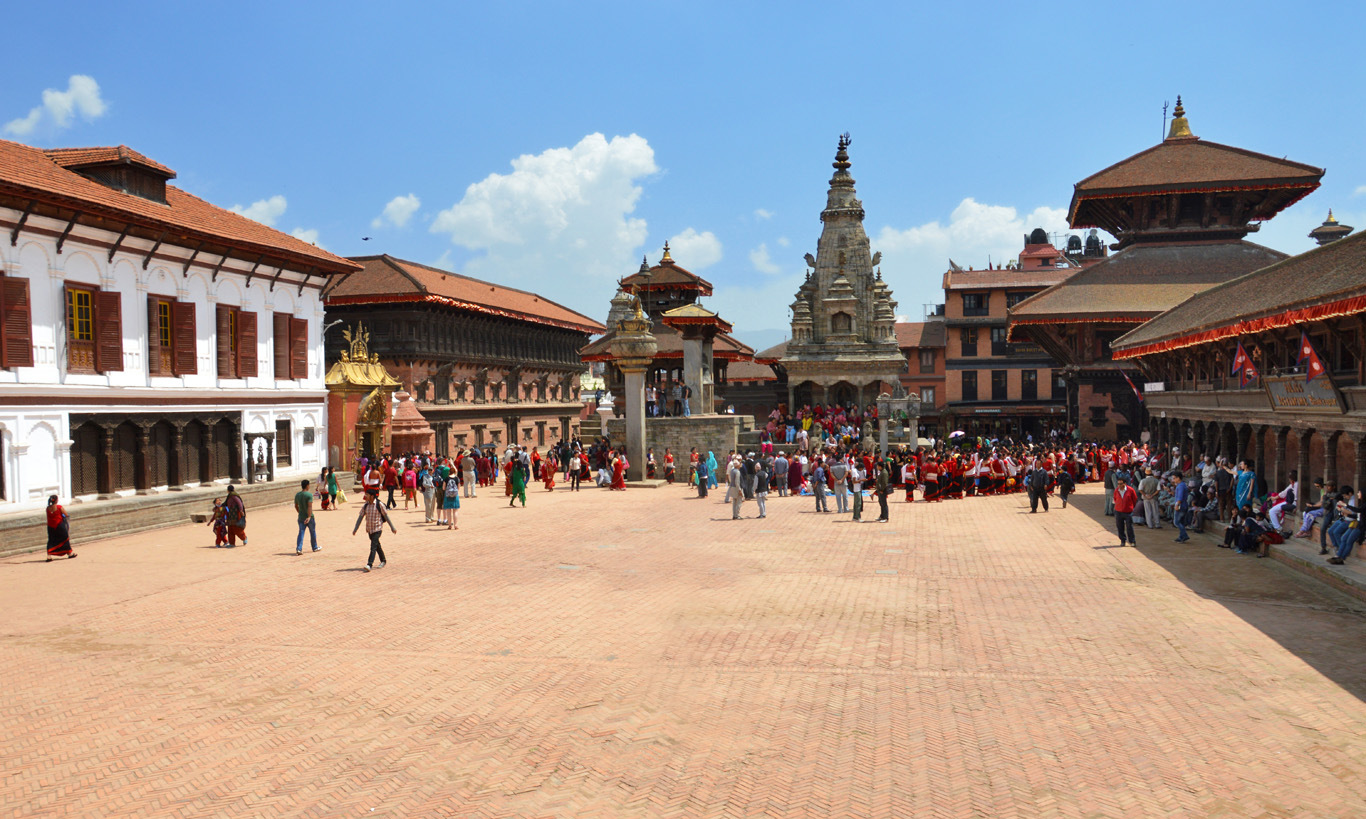
Bhaktapur Durbar Square is not merely a historical precinct but a living testament to Nepal's vibrant festivals, traditions, and daily life. From the grandeur of Bisket Jatra to the devotional nuances of Dashain, the square becomes a focal point of celebrations, with locals and tourists alike being drawn into its enchanting whirl.
As Luxury Holidays Nepal continues to curate exceptional journeys, a visit to Bhaktapur Durbar Square remains a signature experience. We invite you to explore this timeless heritage, immersing in its allure while ensuring an unparalleled voyage through Nepal's golden ages.
Historical Significance of Bhaktapur Durbar Square
The historical legacy of Bhaktapur Durbar Square is deeply rooted in Nepal's cultural and political timelines. This iconic square, located in the heart of Bhaktapur, was the epicenter of power during the reign of the Malla kings. These monarchs, particularly between the 12th and 15th centuries, greatly influenced the architectural and cultural fabric of the region, making Bhaktapur a prominent city in the Kathmandu Valley alongside Kathmandu and Patan.
Over the centuries, Bhaktapur Durbar Square has witnessed the rise and fall of dynasties, societal transformations, and the ebb and flow of trade. The structures within the square, embodying Indo-Maithil, Tibetan, and Newari artistry, stand as testimonials to the city's rich history. These edifices not only offer a window into the past but also emphasize Bhaktapur's undying significance in the annals of Nepali heritage.
Cultural Significance of Bhaktapur Durbar Square
The majestic Bhaktapur Durbar Square, ensconced within the ancient city of Bhaktapur, stands as a testament to Nepal's profound cultural heritage. Unraveling its layers with Luxury Holidays Nepal, one finds that its significance extends far beyond its architectural marvels.
-
Living Heritage: Unlike many historical sites worldwide that stand isolated from daily life, Bhaktapur Durbar Square is a living, breathing entity. Daily rituals, festivals, and ceremonies rooted in centuries-old traditions are still actively practiced here, making the square a dynamic canvas of cultural expressions.
-
Architectural Melting Pot: The array of temples, palaces, and courtyards within the square represents various architectural styles, influenced by both indigenous Newari craftsmanship and external influences over the centuries. This blend is a reflection of Bhaktapur's cosmopolitan past.
-
Center of Arts and Crafts: Bhaktapur has been the cradle of traditional Nepalese arts and crafts. The square itself is adorned with intricate woodwork, metalwork, and stonework, showcasing the city's role as a hub for artisans and craftsmen.
-
Religious Confluence: While primarily associated with Hinduism, the square is also home to shrines and structures linked to Buddhism, showcasing the religious harmony that has characterized Nepal for ages.
-
Festive Hub: The square pulsates with energy during various festivals, the most notable being the Bisket Jatra and Navavarsha (Nepalese New Year). These festivals provide a deep insight into the region's cultural nuances and communal spirit.
-
Cultural Preservation: Despite the ravages of time and calamities, including the devastating 2015 earthquake, the ongoing restoration and preservation efforts symbolize the community's resilience and unwavering commitment to safeguarding its cultural legacy.
Bhaktapur Durbar Square is not just a place; it's an experience. It offers a window into the soul of Nepal, encapsulating the nation's history, spirituality, artistic brilliance, and cultural vibrancy. When one wanders through this square with Luxury Holidays Nepal, they don't just witness monuments; they partake in a timeless dance of rituals, traditions, and stories that have shaped the very fabric of Nepalese society.
Bhaktapur Durbar Square Entry Fee
The entry fees for visiting the old famous heritage site Bhaktapur Durbar Square for Foreign Nations including China, SAARC Nations, Nepalese, and children below 10 are listed in the below table:-
| Site | Bhaktapur Durbar Square |
| Foreign Nations Including China | NPR 1,500 |
| SAARC nationals | NPR 500 |
| Nepalese | Free |
| Below 10 years | Free |
Architectural Highlights of Bhaktapur Durbar Square
Several iconic structures and artworks grace Bhaktapur Durbar Square:
Lion's Gate
Lion's Gate, standing proudly within the precincts of Bhaktapur Durbar Square, is an iconic testament to the architectural and artistic brilliance of Nepal's golden era. Luxury Holidays Nepal is elated to guide enthusiasts through the intricate details of this monumental gateway, offering a deeper understanding of its significance.
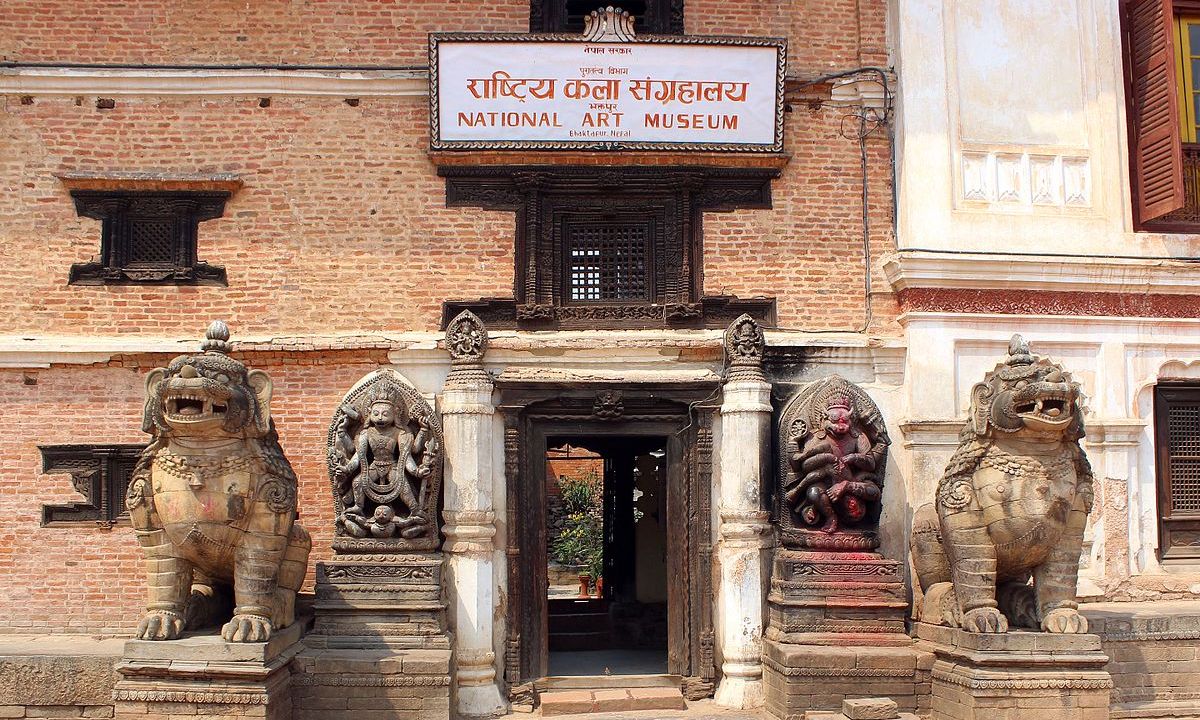
The gate gets its name from the two massive stone statues of lions that flank it, symbolizing strength and courage. These meticulously crafted statues not only serve as gate guardians but also resonate with the valor of the Malla kings, under whose patronage Bhaktapur flourished.
Apart from the lion statues, the gate itself is adorned with magnificent carvings that exhibit the prowess of Newari artisans. Legends associated with Lion's Gate suggest that it stands as a tribute to the bravery displayed by Malla kings during times of war, emphasizing their commitment to protect their realm.
The Golden Gate
One of the most ornate and mesmerizing pieces of artistry within Bhaktapur Durbar Square is undoubtedly the Golden Gate. As a focal highlight presented by Luxury Holidays Nepal, this gate, locally known as "Sun Dhoka," stands as a symbol of Bhaktapur's aesthetic zenith and the intricate craftsmanship of Nepal's medieval era.
Erected as the entrance to the main courtyard of the 55-Window Palace, the Golden Gate offers an unmatched display of repoussé metalwork. The shimmering façade, embellished with gold, showcases an ensemble of mythical creatures, deities, and intricate motifs. At the center is the figure of the goddess Taleju, surrounded by a cavalcade of celestial beings, each crafted with meticulous detail.
What makes the Golden Gate even more special is its backdrop of tales and legends. It's said that when King Bhupatindra Malla commissioned the gate, he demanded perfection. The artisan responsible for its creation, fearing any flaw might cost him his life, threw himself into the molten metal mixture to ensure the work's flawlessness.
55-Window Palace
Among the many architectural wonders of Bhaktapur Durbar Square, the 55-Window Palace stands out as a symbol of regal elegance and sophisticated craftsmanship. Luxury Holidays Nepal takes immense pride in introducing visitors to this iconic edifice, reflecting the pinnacle of Malla-era architecture.

The 55-Window Palace, as its name suggests, is renowned for its grand wooden balcony that showcases fifty-five meticulously carved windows. Crafted during the reign of King Yaksha Malla in the 15th century and later expanded upon by King Bhupatindra Malla in the 17th century, the palace serves as a magnificent testimony to the wood-carving traditions of Nepal. Each window frame, adorned with intricate patterns and motifs, narrates tales of mythology, valor, and devotion.
Apart from its famed balcony, the palace boasts a series of courtyards, temples, and artistic embellishments that highlight the cultural and religious significance of the era. The palace once served as the royal seat of Malla kings and has witnessed numerous historical events, royal ceremonies, and cultural celebrations.
Vatsala Temple
Nestled within the architectural ensemble of Bhaktapur Durbar Square, the Vatsala Temple stands as a beacon of spiritual devotion and exquisite craftsmanship. As part of the curated experiences by Luxury Holidays Nepal, this temple invites visitors to delve deep into the artistry and religious significance rooted in Nepal's rich cultural tapestry.
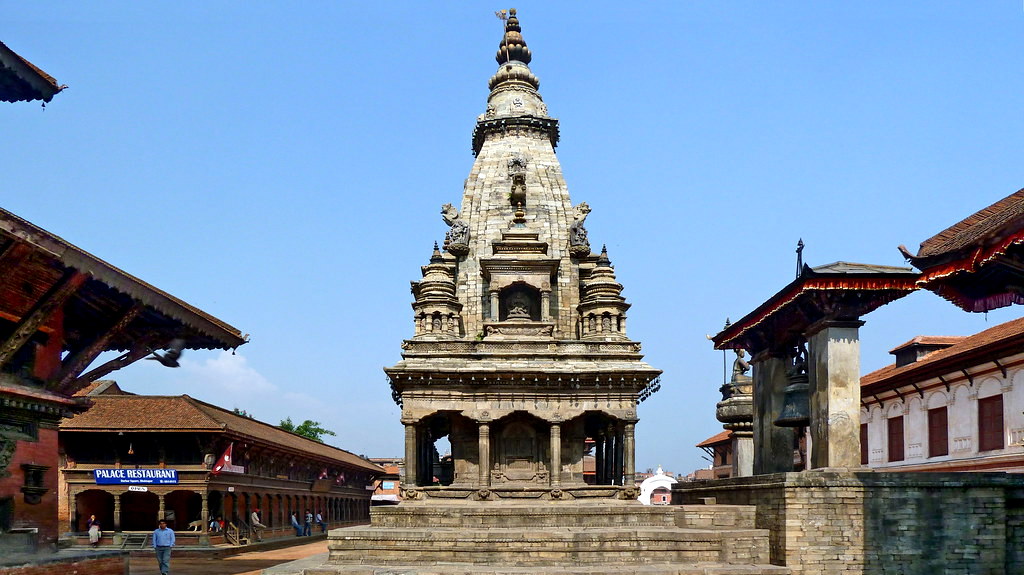
The Vatsala Temple is a splendid example of Shikhara-style architecture, prevalent in the Kathmandu Valley. Crafted primarily from finely chiseled sandstone, the temple emanates an aura of timeless elegance. Its intricate carvings, depicting various deities, floral motifs, and mythical creatures, showcase the meticulous attention to detail by the artisans of yore.
One of the temple's standout features is its silver door, which exudes a radiant sheen, drawing the gaze of devotees and tourists alike. Adjacent to the temple stands the iconic 'bell of barking dogs', a significant artifact, especially during rituals and ceremonies when it's rung to ward off evil spirits.
Mini Pashupati Temple
In the heart of Bhaktapur Durbar Square, amid its myriad of architectural wonders, lies the Mini Pashupati Temple. Often overshadowed by its grander counterparts, this temple, presented to visitors by Luxury Holidays Nepal, holds its own unique charm and significance, serving as a spiritual bridge between Bhaktapur and the revered Pashupatinath Temple of Kathmandu.
Although smaller in scale, the Mini Pashupati Temple does not compromise on intricacy and design. Architecturally, it mirrors the larger Pashupatinath Temple, with its tiered roof, silver-plated entrance, and exquisitely carved wooden struts. The deity enshrined within is Lord Shiva, revered and worshipped with equal fervor by the locals.
Interestingly, the temple is also colloquially termed "Yaksheswor Mahadev Temple." Its creation is shrouded in legends, with some accounts suggesting it was constructed by King Yaksha Malla, hence the name. Another intriguing aspect is the presence of erotic carvings on the temple's struts, similar to those found on some other temples in Nepal, which resonate with Tantric traditions.
The Picture Gallery/ National Art Museum
Located adjacent to the 55-Window Palace in Bhaktapur Durbar Square stands a repository of Nepal's artistic heritage: The Picture Gallery, also known as the National Art Museum. Through curated experiences by Luxury Holidays Nepal, art enthusiasts and history buffs are offered a chance to immerse themselves in a world of vibrant palettes, intricate details, and stories captured in visuals.
The Picture Gallery boasts a vast collection of Tantric cloth paintings, locally referred to as 'paubhas' in Nepali. These paubhas depict intricate depictions of Hindu and Buddhist deities, interspersed with mythological tales, rituals, and symbols. Apart from the cloth paintings, the gallery is also home to numerous other art pieces, including sculptures, manuscripts, and ritual objects, each narrating a tale from Nepal's rich artistic past.
What makes the National Art Museum unique is its location within a historical setting. Housed in a traditional building adorned with woodwork and ornate carvings, the museum itself stands as an architectural marvel. The juxtaposition of the building's Malla-era architecture with the art pieces it houses creates a harmonious blend of form and content.
Nyatapola Temple
Soaring above Bhaktapur Durbar Square, the Nyatapola Temple stands as a beacon of architectural magnificence and cultural pride. It's with immense reverence and enthusiasm that Luxury Holidays Nepal introduces visitors to this iconic five-storied pagoda, the tallest temple in Nepal and a hallmark of Newari craftsmanship.
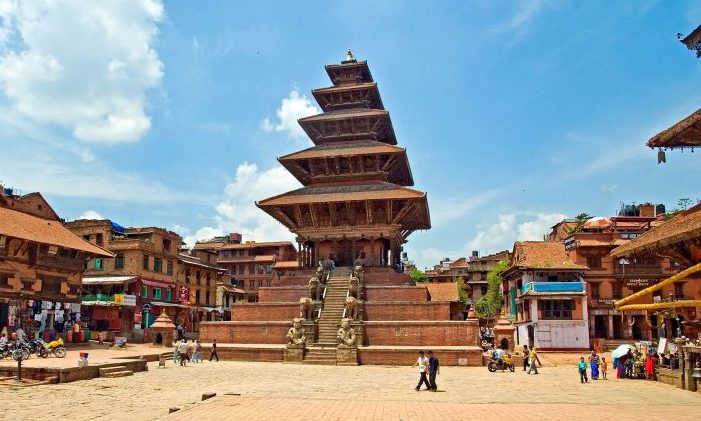
Constructed during the reign of King Bhupatindra Malla in the early 18th century, the Nyatapola Temple is dedicated to Siddhi Lakshmi, an incarnation of the goddess Parvati. The temple is renowned not only for its grandeur but also for its resilience, having withstood numerous earthquakes over the centuries, including the devastating 2015 earthquake, with minimal damage.
Ascending the steps to the temple, visitors encounter a series of guardian statues, each more powerful than the next, symbolizing the strength and protection offered to the deity within. Starting from the legendary wrestlers Jayamel and Phattu at the base, followed by elephants, lions, griffins, and finally the tantric goddesses Singhini and Baghini, each pair serves both as a testament to Bhaktapur's rich lore and as a marvel of stone craftsmanship.
Bhairab Nath Temple
Among the plethora of spiritual and architectural gems in Bhaktapur Durbar Square, the Bhairab Nath Temple holds a place of profound significance. As Luxury Holidays Nepal guides visitors through the labyrinthine alleys and courtyards of Bhaktapur, this particular temple resonates with tales of valor, devotion, and the transformative nature of the divine.
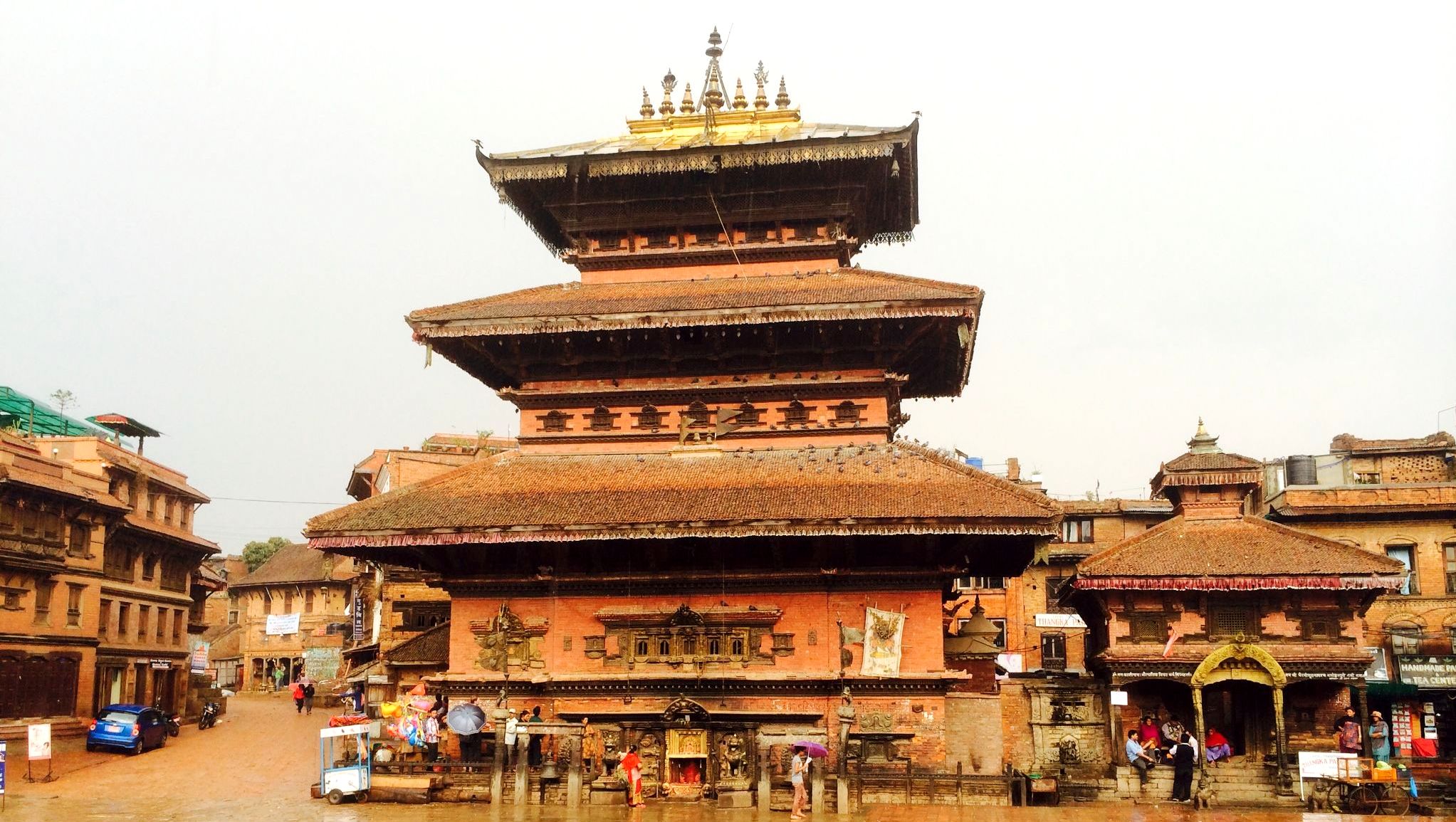
Dedicated to Lord Bhairab, the fiercest incarnation of Lord Shiva, the Bhairab Nath Temple stands as a three-storied edifice, exuding an aura of awe and reverence. Bhairab, often depicted with wrathful eyes, a crown of skulls, and a garland of severed heads, symbolizes destruction, but equally, creation. His fierce demeanor is a reminder of the transient nature of life and the inevitable cycle of birth, death, and rebirth.
Architecturally, the temple is the epitome of Newari craftsmanship. Its wooden struts, embellished with intricate carvings, portray various episodes from Hindu scriptures. The bronze bell, a notable feature of the temple, is often rung during ceremonies and rituals, its deep resonating sound echoing the profound depths of devotion.
Dattatreya Temple
Venturing beyond the bounds of Bhaktapur Durbar Square, one discovers another architectural and spiritual marvel, the Dattatreya Temple. Through the lens of Luxury Holidays Nepal, this temple emerges not only as a significant religious site but also as a symbol of Bhaktapur's rich cultural heritage and vibrant community life.
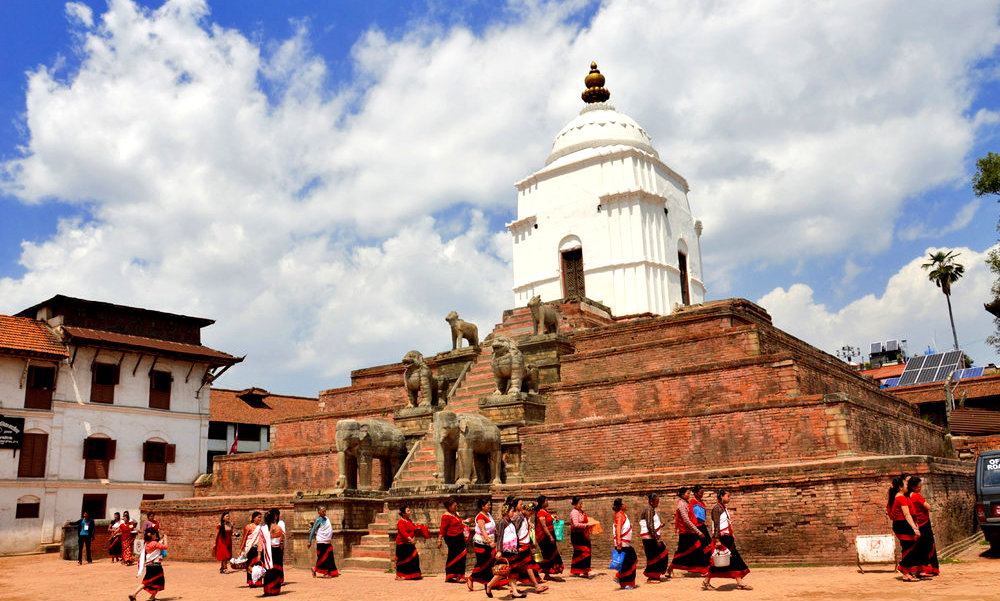
Situated in the Dattatreya Square, the Dattatreya Temple is dedicated to the triune deity Dattatreya, believed to be a fusion of the Hindu trinity - Brahma, Vishnu, and Shiva. Legends say that the temple was constructed from a single piece of wood from a single tree. It stands as the epitome of the impressive woodwork for which Bhaktapur is renowned.
The temple's architecture reflects the Malla-era aesthetics. It's adorned with intricately carved wooden windows and doors, with motifs that resonate with both Hindu and Buddhist iconography. Flanking the temple are two guardian sculptures, the legendary Rajput wrestlers Jayamel and Phattu, believed to have the strength of ten men.
Statue of Bhupatindra Malla
At the very heart of Bhaktapur Durbar Square, amidst its vast array of temples and architectural wonders, stands a tribute to one of its most illustrious rulers – the Statue of Bhupatindra Malla. Guided by the insights from Luxury Holidays Nepal, visitors are introduced to this emblematic representation of a king who played an instrumental role in shaping Bhaktapur's cultural and architectural landscape.
Perched atop a column, the life-sized Statue of Bhupatindra Malla portrays the king in a regal pose of devotion, with folded hands, symbolizing his unwavering faith and dedication to the deities and his kingdom. King Bhupatindra Malla, who reigned during the 17th century, is credited with commissioning many of the architectural masterpieces in Bhaktapur, including the iconic Vatsala and Nyatapola temples.
The intricacy with which the statue has been crafted speaks volumes of the skilled artisans of the time. Every detail, from the ornate crown adorning the king's head to the regalia he's draped in, mirrors the opulence and grandeur of the Malla dynasty. The column, on which the statue is mounted, is itself an architectural marvel, adorned with various inscriptions and motifs.
Siddha Pokhari
On the eastern edge of the ancient city of Bhaktapur, a stone's throw away from the bustling alleys and majestic temples, lies a tranquil haven known as Siddha Pokhari. This historical pond, introduced to travelers by Luxury Holidays Nepal, offers a serene juxtaposition to the urban setting, making it a favored spot for both locals and tourists alike.

Siddha Pokhari, also known as "Ta Pukhu" by the locals, spans a considerable expanse and dates back to the medieval period, constructed during the reign of King Yaksha Malla in the early 15th century. Its rectangular design, complete with traditional stone steps leading to the water's edge, is a typical representation of Nepalese pond architecture.
Overlooking the serene waters are several shrines and resting areas, where visitors often find respite and indulge in moments of reflection. During the early mornings and late afternoons, the pond becomes a social hub, with locals congregating for conversations, and rituals, and feeding the myriad of fish that inhabit the pond, believed to be sacred.
Taumadhi Square
Just south of the renowned Bhaktapur Durbar Square lies another bustling arena that encapsulates the essence of Bhaktapur's cultural vibrancy: Taumadhi Square. Guided by the expertise of Luxury Holidays Nepal, visitors are immersed in a rich tapestry of history, architecture, and local life that unfolds in this square.
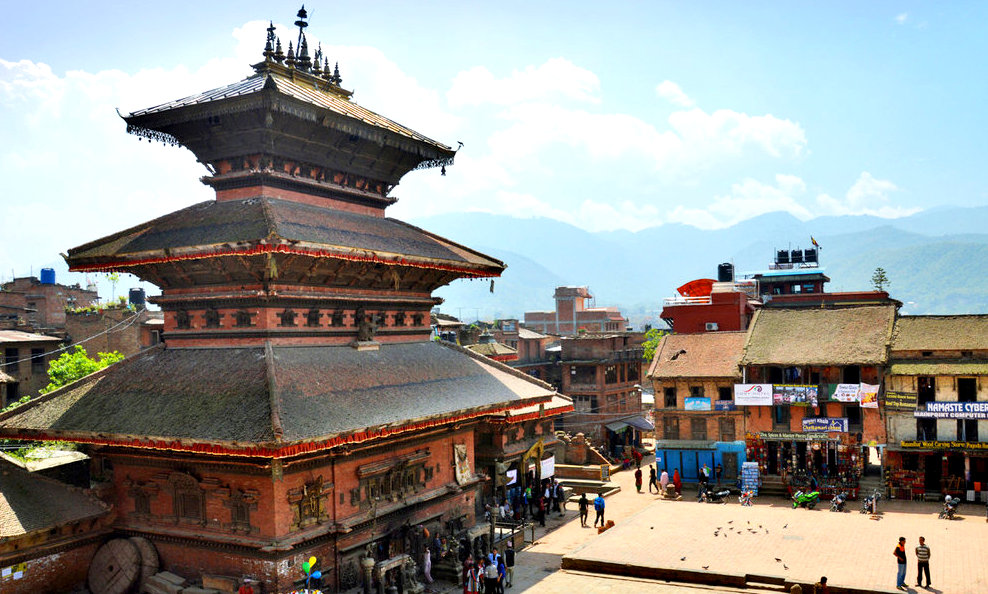
The most dominant and awe-inspiring structure in Taumadhi Square is undoubtedly the Nyatapola Temple. Towering over the square with its five-tiered structure, this temple is the tallest in Nepal and stands as a testament to the architectural prowess of the Newar craftsmen of the time. The ascending stairway to the temple, flanked by stone statues of guardians, is both a visual and spiritual journey, leading one closer to the divine with each step.
Adjacent to Nyatapola, the smaller but equally significant Bhairab Nath Temple commands attention. With its wooden carvings and intricate details, it pays homage to the fierce incarnation of Lord Shiva. The square is also dotted with several smaller shrines, pagodas, and traditional Newari houses, each with its own tale to tell.
But Taumadhi Square is not just about its monumental edifices. It's a living, breathing space. On any given day, the square is abuzz with activity – local artisans selling their crafts, musicians playing traditional instruments, and devotees offering prayers. The local festivals, especially the Bisket Jatra, transform the square into a riot of colors, sounds, and emotions.
Tips for While Visiting Bhaktapur Durbar Square
Here are the tips while Visiting Bhaktapur Durbar Square:
- Stay Hydrated: Especially if visiting during the warmer months, ensure you carry a bottle of water. Although there are local vendors, having your own can be convenient.
-
Footwear: The square is best explored on foot, so wear comfortable walking shoes. Remember, you'll need to remove them when entering certain temples and sacred areas.
-
Beware of Pickpockets: Like any popular tourist spot, there's a potential for pickpockets. Keep your belongings secure and be aware of your surroundings.
-
Explore Early or Late: The square can get quite busy during midday. If you prefer a quieter experience, try visiting early in the morning or later in the afternoon.
-
Taste Local Delicacies: Don't miss out on trying traditional Newari dishes available in the local eateries around the square.
-
Photography: Always be respectful when taking photos. Some areas within the Durbar Square might have restrictions on photography, especially inside the temples.
-
Entry Tickets: Retain your entry ticket, especially if you plan to visit multiple times or over several days. It may be checked upon re-entry.
-
Stay Aware: As Bhaktapur Durbar Square is a popular tourist destination, be wary of aggressive vendors.
-
Contribute to Preservation: The square has endured various natural calamities, including earthquakes. When you pay the entry fee or donate to the temples, you contribute to the preservation of this UNESCO World Heritage site.
-
Experienced Guide: To make the most of your visit, Luxury Holidays Nepal provides experienced guides who can offer deeper insights into the rich history and significance of the square.
Remember, Bhaktapur Durbar Square is not just a tourist attraction but a living testament to Nepal's rich cultural and historical legacy. Treat the place with the respect and reverence it deserves.
In the heart of ancient Bhaktapur, the Bhaktapur Durbar Square stands as a monumental testament to Nepal's rich history, artistic prowess, and cultural heritage. A treasure trove of architectural marvels, this UNESCO World Heritage Site captivates visitors with its intricate carvings, grand palaces, and vibrant festivals. Each stone, courtyard, and temple narrates tales of bygone eras, making a visit to this iconic square not just a journey through space but also a voyage back in time. Through the lens of Luxury Holidays Nepal, the square transcends its physical boundaries, offering a deep dive into the soul of Nepali traditions and legacy.
Frequently Asked Questions for Bhaktapur Durbar Square
Q: Where is Bhaktapur Durbar Square located?
A: Bhaktapur Durbar Square is located in Bhaktapur, approximately 12 kilometers east of Kathmandu, the capital city of Nepal.
Q: Is there an entrance fee for Bhaktapur Durbar Square?
A: Yes, there's an entrance fee for international tourists. The fee goes towards the maintenance and conservation of this UNESCO World Heritage Site. It's advisable to check current rates, as they may vary.
Q: How much time should I allocate for a visit?
A: While a quick visit might take a couple of hours, to truly immerse yourself in the history, culture, and architecture of the square, it's recommended to allocate at least half a day.
Q: Are there any eateries nearby?
A: Yes, around and within the vicinity of the square, you'll find several eateries offering both local Newari delicacies and international cuisines.
Q: Can I take photographs inside the temples?
A: While photography is allowed in many parts of the square, some temples and shrines might have restrictions, especially inside. It's always best to check for signs or ask the temple custodians.
Q: Are there any festivals celebrated in the square?
A: Bhaktapur Durbar Square is a hub of cultural celebrations. The most notable festivals include Bisket Jatra and Navavarsha (Nepalese New Year). However, numerous other festivals and rituals take place throughout the year.
Q: Is it safe to visit?
A: Yes, Bhaktapur Durbar Square is generally safe for tourists. However, as with any popular tourist destination, it's always wise to be aware of your belongings and surroundings.
Q: What's the best time of year to visit?
A: While Bhaktapur Durbar Square can be visited year-round, the months between October to December and March to May offer pleasant weather, making it ideal for exploration.
If you are looking for tour packages in Nepal, please click here.
If you need any further information, please contact us by email: [email protected], Phone: +977- 985 100 5129 (WhatsApp)